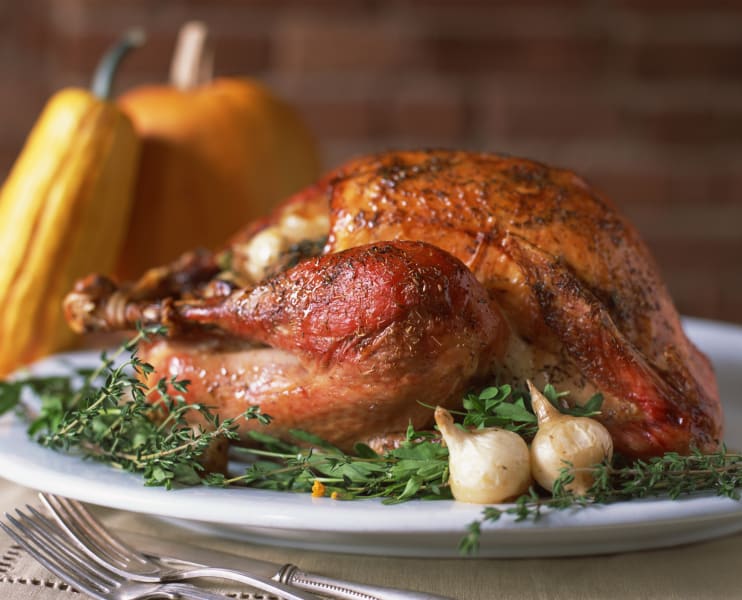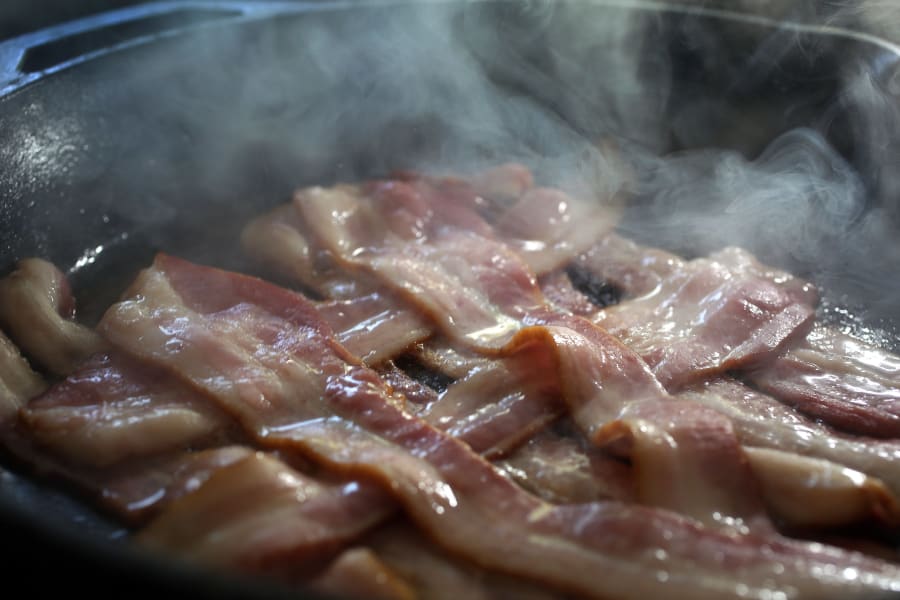Share


1 of 10
Beef is widely recognized as the most climate-damaging of all foods. A 2017 study by the Natural Resources Defense Council on food consumption in the US calculates that each kilogram of beef produces 26.5 kilograms of CO2 emissions -- the highest among all the foods observed in the study, and five times more than chicken or turkey meat.
Animal agriculture is responsible for 14.5% of the world's greenhouse emissions, according to the UN's Food and Agriculture Organization, making it a significant contributor to climate change. Of those emissions, 65% come from beef and dairy cattle.
Reducing beef consumption is an effective way of curbing global emissions. According to the NRDC, Americans now consume 19% less beef than they did in 2005. This is equivalent to a reduction of 185 million metric tons of emissions, or the annual tailpipe pollution of 39 million cars.
But why is beef so bad? "The feed is largely produced using lots of pesticide and fertilizer, which requires fossil fuels," explains Sujatha Bergen, one of the authors of the study. "Also, the digestive system of the cows produces methane, which is 25 times more potent a greenhouse gas than carbon dioxide. And the manure emits additional greenhouse gases." Jupiterimages
Animal agriculture is responsible for 14.5% of the world's greenhouse emissions, according to the UN's Food and Agriculture Organization, making it a significant contributor to climate change. Of those emissions, 65% come from beef and dairy cattle.
Reducing beef consumption is an effective way of curbing global emissions. According to the NRDC, Americans now consume 19% less beef than they did in 2005. This is equivalent to a reduction of 185 million metric tons of emissions, or the annual tailpipe pollution of 39 million cars.
But why is beef so bad? "The feed is largely produced using lots of pesticide and fertilizer, which requires fossil fuels," explains Sujatha Bergen, one of the authors of the study. "Also, the digestive system of the cows produces methane, which is 25 times more potent a greenhouse gas than carbon dioxide. And the manure emits additional greenhouse gases." Jupiterimages
Another ruminant, lamb, comes at number two -- confirming that red meat is particularly resource-intensive and, as such, damaging to the environment. For each kilo of lamb meat consumed, there are 22.9 kilos of emissions, the NRDC study estimates.
Meat production also requires large amounts of animal feed, mainly the resource-intensive corn and soy. The synthetic fertilizer and the manure used to grow these also releases nitrous oxide, a climate-warming pollutant 298 times more powerful than carbon dioxide. PETER PARKS/AFP/AFP/Getty Images
Meat production also requires large amounts of animal feed, mainly the resource-intensive corn and soy. The synthetic fertilizer and the manure used to grow these also releases nitrous oxide, a climate-warming pollutant 298 times more powerful than carbon dioxide. PETER PARKS/AFP/AFP/Getty Images
The third most damaging food, by some distance, is butter: one kilo of butter equals nearly 12 kilos of CO2 -- about half as many as beef. It belongs to the same supply chain, making dairy and beef cattle an environmentalist's nightmare.
While Americans have greatly reduced their consumption of red meat in recent years, the NRDC reports that butter and other dairy products such as cheese and yogurt actually enjoyed a surge in the observed period, from 2005 to 2014.
Butter is the most climate damaging of all dairy products because there are several steps involved in producing it that are energy-intensive: "For example, butter production requires separating raw milk into low-fat milk and cream, pasteurizing the cream, cooling the cream, ripening and churning," Sujatha Bergen told CNN. Riou/Digital Vision/Getty Images
While Americans have greatly reduced their consumption of red meat in recent years, the NRDC reports that butter and other dairy products such as cheese and yogurt actually enjoyed a surge in the observed period, from 2005 to 2014.
Butter is the most climate damaging of all dairy products because there are several steps involved in producing it that are energy-intensive: "For example, butter production requires separating raw milk into low-fat milk and cream, pasteurizing the cream, cooling the cream, ripening and churning," Sujatha Bergen told CNN. Riou/Digital Vision/Getty Images
Shellfish costs the environment 11.7 kilos of CO2 for every kilo of food produced, just marginally less than butter. Along with milk, pork, and high-fructose corn syrup -- widely used as a sweetener in soft drinks -- shellfish is among the key foods that Americans are eating less of. Overall, changes in the American diet since 2005 have led to a 10% decrease in per-capita climate pollution related to food, according to the NRDC. Brendon Thorne/Getty Images AsiaPac/Getty Images
Another dairy product, cheese, comes in fifth place with 9.8 kg of emissions per kg produced. "Our list is a an average of several common cheeses," explains Sujatha Bergen, "Cheeses that require refrigerated transport or are flown in from abroad, however, tend to have higher climate impacts." Joe Raedle/Getty Images North America/Getty Images
The only vegetable on the list is also the most surprising entry. Asparagus creates 8.9 kilos of emissions per kilo produced, according to the NRDC. But how?
The problem is mostly in the air miles. NRDC's Sujatha Bergen explains: "Much of the asparagus in the United States is flown in from Latin America, which results in greater climate emissions than foods that are transported by trucks. While it's not the only produce item that is flown into the country, a higher proportion of it is transported this way than most other common fruits and vegetables (many of which we import from Mexico). In general, if people are looking to minimize their climate impacts, they should avoid air freighted foods as much as possible." SAUL LOEB/AFP/AFP/Getty Images
The problem is mostly in the air miles. NRDC's Sujatha Bergen explains: "Much of the asparagus in the United States is flown in from Latin America, which results in greater climate emissions than foods that are transported by trucks. While it's not the only produce item that is flown into the country, a higher proportion of it is transported this way than most other common fruits and vegetables (many of which we import from Mexico). In general, if people are looking to minimize their climate impacts, they should avoid air freighted foods as much as possible." SAUL LOEB/AFP/AFP/Getty Images
One kilo of pork creates 7.9 kilos of carbon emissions. The NRDC estimates that changes in the American diet avoided approximately 271 million tons of climate-warming pollution between 2005 and 2014, roughly equivalent to the tailpipe pollution of 57 million cars for one year. In the list of foods that contributed the most to this reduction, pork is third behind beef and orange juice. Joe Raedle/Getty Images North America/Getty Images
Another entry that belongs to the beef and dairy cattle supply chain, veal has a lower environmental impact than beef because the calves are slaughtered at a younger age, typically at around 20 weeks versus 18 months. Each kilo creates 7.8 kilos of carbon emission, according to the NRDC. PHILIPPE HUGUEN/AFP/AFP/Getty Images
Eating less chicken meat is one of the contributing factors that have led to a reduction in per-capita emissions linked to food in the US, but poultry still ranks in the top 10, with just over five kilograms of CO2 per kilogram of product. Courtesy Neil Conway/Creative Commons/Flickr
Turkey has the same carbon footprint as chicken, at around 5 kilos of emissions per kilo of meat.
The NRDC has excluded from this list some foods that most people are not familiar with or are difficult to deliberately avoid, because they are often used in ingredients in other products as opposed to purchased directly by consumers in large amounts. These include: lard and beef tallow (11.92 kg of CO2 per kg of food), dry milk products (10.4 kg of CO2 per kg of food), and other added fats and oils such as palm oil (6.30 kg of CO2 per kg of food).
The NRDC has excluded from this list some foods that most people are not familiar with or are difficult to deliberately avoid, because they are often used in ingredients in other products as opposed to purchased directly by consumers in large amounts. These include: lard and beef tallow (11.92 kg of CO2 per kg of food), dry milk products (10.4 kg of CO2 per kg of food), and other added fats and oils such as palm oil (6.30 kg of CO2 per kg of food).

















